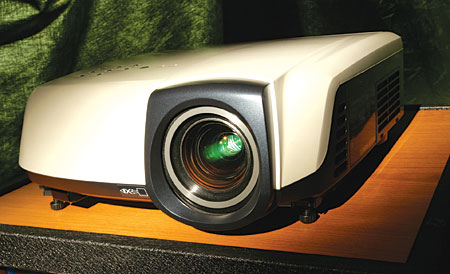1080p Projector Rodeo Mitsubishi HC5000
New Kid, Low Price, Lots of Features
Mitsubishi hasn't had too much of a presence in the front-projector market, although their forays have tended to be good. Their 1080p offering, the HC5000, is the oddball in this group. It's the only one that uses LCDs to make its image. It's also the cheapest, and it's the only one that uses a name-brand (as in not in-house) scaler chip—Silicon Optix's Reon.

The menus are kind of small, like the Sony's, but they're also harder to read. The remote is fully backlit and has lots of useful buttons. There are three presets that you can save for your menu adjustments; but be careful, as it's easy to mistakenly press the buttons on the remote that will delete any changes you've made.
All of the adjustments for the lens are motorized and are therefore on the remote. The case isn't bad looking, but it looks more like what you'd see on a budget projector. The Sony may only be 11 percent more expensive, but its case makes it look like it would be significantly more.
Setup is made difficult by a control labeled, ironically, Setup. Out of the box, the HC5000 badly crushes blacks. You will need to find the Setup control in the menu and turn it off. Why it would be enabled as the default setting is beyond me.
 Like the Sony, the HC5000 has an automatic iris. An auto iris (or dynamic iris, if you prefer) tracks the incoming video signal and adjusts the iris depending on, generally, the average brightness level. So, if the scene is dark, the iris closes, giving you a better black level. If the scene is bright, the iris opens and makes the image brighter. This artificially inflates the full-on/full-off contrast-ratio numbers. So, what you see on the screen is somewhere between the 5,600:1 full-on/full-off contrast ratio with the auto iris going full bore and the 660:1 it produces when it is set to Open. LCD technology has come a long way in recent years, but its native contrast-ratio ability still can't match that of DLP or LCOS. As a result, the image on the screen was flatter than with the other two projectors. It was more apparent that I was watching a display instead of watching a movie. That said, it's a lot better than LCD projectors have been in the past.
Like the Sony, the HC5000 has an automatic iris. An auto iris (or dynamic iris, if you prefer) tracks the incoming video signal and adjusts the iris depending on, generally, the average brightness level. So, if the scene is dark, the iris closes, giving you a better black level. If the scene is bright, the iris opens and makes the image brighter. This artificially inflates the full-on/full-off contrast-ratio numbers. So, what you see on the screen is somewhere between the 5,600:1 full-on/full-off contrast ratio with the auto iris going full bore and the 660:1 it produces when it is set to Open. LCD technology has come a long way in recent years, but its native contrast-ratio ability still can't match that of DLP or LCOS. As a result, the image on the screen was flatter than with the other two projectors. It was more apparent that I was watching a display instead of watching a movie. That said, it's a lot better than LCD projectors have been in the past.
While the iris helps the overall image, it's a little slow. This adds an artifact of its own. If the scene shifts from bright to dark (or dark to bright) abruptly, it takes a moment for the iris to catch up. This results in a fairly quick ramp up or ramp down in the brightness level on the screen. You probably won't notice this on most video material.
Processing is this projector's strong suit. With film-based content, it picks up the 3:2 sequence with both 1080i and 480i material quickly. It looked the best out of all three of these projectors with the Gladiator test scene. The HC5000's video processing was also excellent. It deinterlaces 1080i correctly. With the waving-flag scene, it showed the fewest jagged edges in this rodeo, and it looked better than most displays we've reviewed recently. The rotating bar also looked the best in this test, although you would hope so, as that test is from a Silicon Optix test disc, and the HC5000 uses Silicon Optix processing.
More subtle—but perhaps more commendable—is the very small amount of noise in the image. It was noticeably lower than with the other projectors here. It was perhaps not quite as low as with the über-clean Yamaha DPX-1300, but it was pretty close. That's not bad for less than half the price. With The Fifth Element, the HC5000 was perhaps a little more detailed than the other projectors, but it was a very close race.
It may not have the Sony's sexy case or the JVC's incredible contrast ratio, but the little Mits that could holds its own against two very heavy hitters. A few programming quirks aside (stop crushing blacks!), it's the processing that keeps the HC5000 afloat. It passed every test I threw at it. There's no need to worry about scalers, scaling DVD players, or 1080i-only outputs. It's too bad the HC5000's LCD panels, although far improved over previous generations, can't produce the numbers of its LCOS (or DLP) competitors.
Highlights
Mitsubishi HC5000 LCD Projector:
• Superlative processing
• Great detail and low noise
- Log in or register to post comments




































































